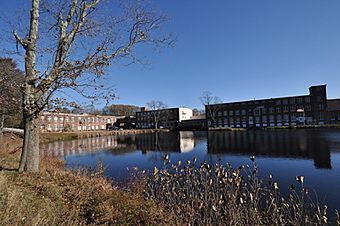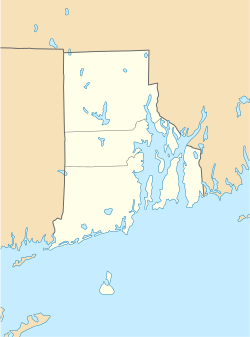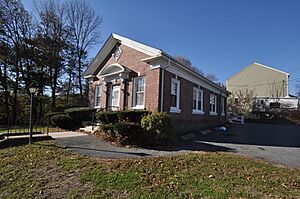Saylesville, Rhode Island facts for kids
Quick facts for kids |
|
|
Saylesville Historic District
|
|

Saylesville Mills
|
|
| Location | Lincoln, Rhode Island |
|---|---|
| Built | 1854 |
| Architectural style | Italianate |
| MPS | Lincoln MRA |
| NRHP reference No. | 84002049 |
| Added to NRHP | August 30, 1984 |
Saylesville is a small village in Lincoln, Rhode Island, USA. It's also a special "historic district," which means it has many old buildings and places that are important to history.
Contents
A Look at Saylesville's Past
Early Days: Farms and Faith
Saylesville started as a farming area way back in the 1600s. You can still find very old buildings nearby. For example, the historic Eleazer Arnold House was built in 1693. The Saylesville Meeting House, built in 1704, is one of the oldest Quaker (Society of Friends) meeting houses in New England. It's also one of the oldest church buildings in all of Rhode Island.
The Rise of Mill Towns
In the 1800s, things changed a lot. A man named William F. Sayles started the Sayles Bleacheries. These were factories that processed cloth. Saylesville became a "mill town." This means it was a town built mostly around a factory. William's son, Frank Sayles, built many homes for the factory workers and managers. Many of these original homes are still standing today.
By the 1920s, Frank Sayles had made his textile finishing business huge. It was one of the biggest in the world! But after he passed away in 1920, the textile industry in the Northeast started to slow down. Factories began moving to the southern United States where it was cheaper to operate.
Tough Times for Workers
The mill towns in Rhode Island faced hard times. In 1934, many textile workers went on a big strike. Saylesville saw some of this action. Thousands of workers protested near the mill. They wanted the factory to close down.
A serious event happened at the Moshassuck Cemetery. Strikers and the Rhode Island National Guard had a confrontation. Many people were hurt, and one person died. The mills in Saylesville finally closed in the 1960s.
A Helpful Businessman
William F. Sayles, who started the mills, was also a kind person. He gave money to build the Memorial Hospital of Rhode Island in Pawtucket. This hospital still helps people today.
In the 1920s, Saylesville even had its own professional soccer team! They were called the Sayles Finishing Plant F.C..
Saylesville Today
Community Services
Today, Saylesville has its own fire department. It's called the Saylesville Fire District. This department has both paid firefighters and volunteers. They use different fire trucks and even a boat to help keep the community safe. The district covers Saylesville, Fairlawn, Lonsdale, and part of Lincoln Woods State Park.
The Historic District
The Saylesville Historic District is a special area. It includes many important old homes, especially along Chapel and Walker Streets. These streets are near Saylesville Pond. The district also extends to Smithfield Avenue and Woodland Court.
The public buildings in the village are mostly on Walker Street. The homes for mill workers on Chapel and Smithfield streets are a mix of single-family houses and buildings with two or more units. They are made of wood or brick. The company tried to make the town look less uniform than other mill villages. They built similar houses in different spots so they weren't all in a row.
The Saylesville Meetinghouse, which is still used by Quakers, is on Great Road. It was built in 1703 but is not part of the historic district itself. The Saylesville Historic District was added to the National Register of Historic Places in 1984.




